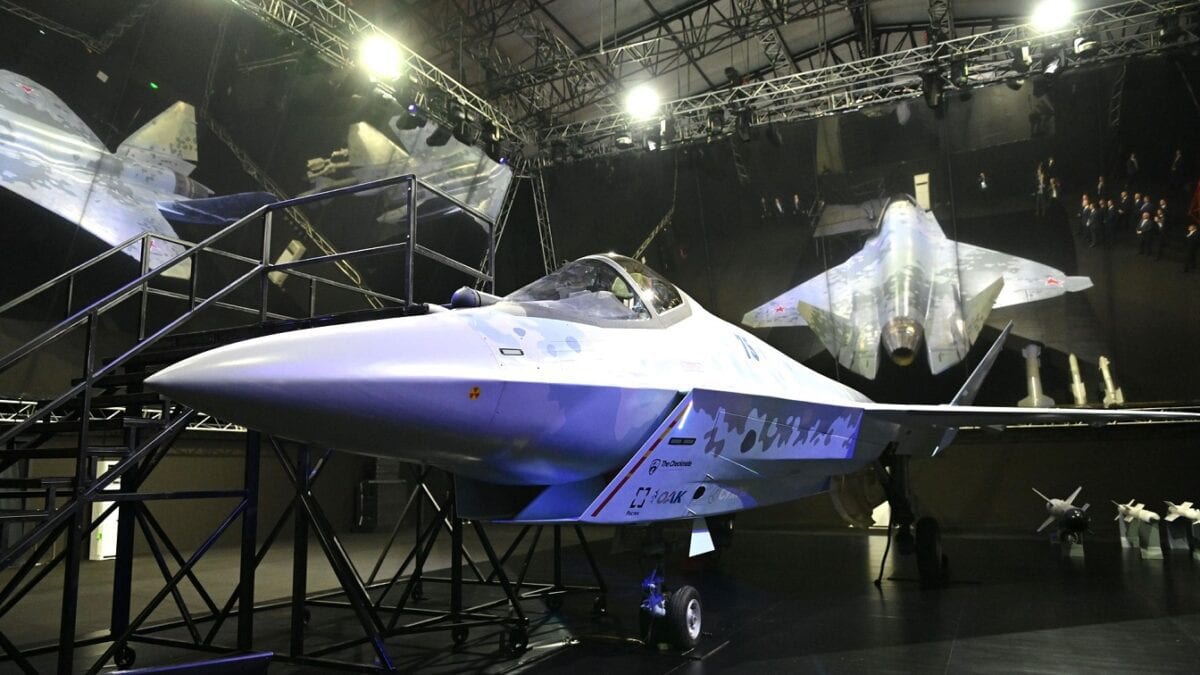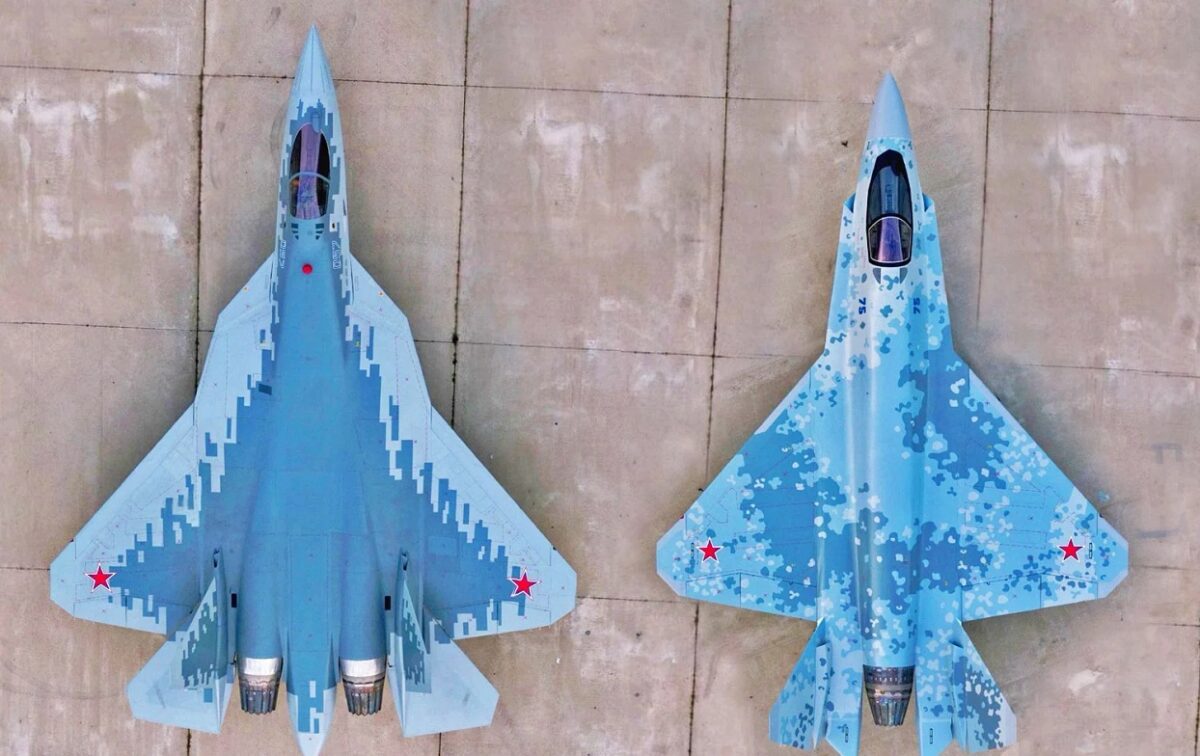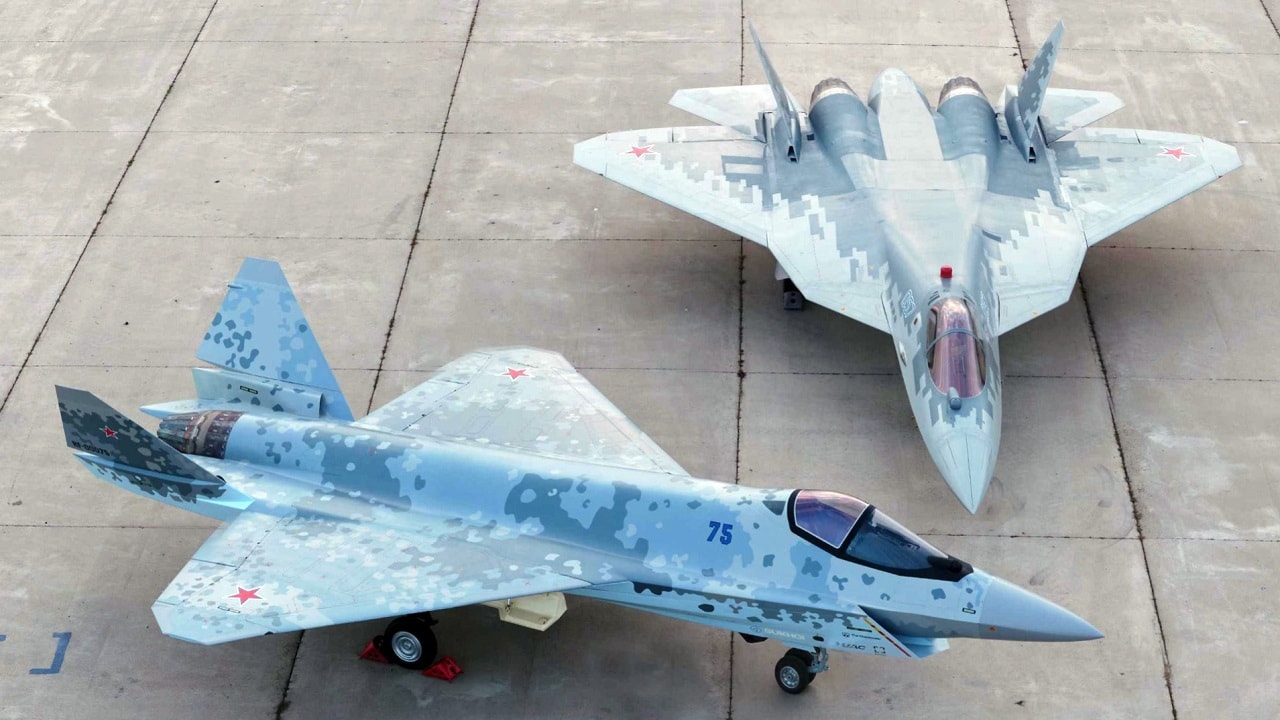Will the Su-75 still have an export market? – A static Sukhoi Su-75 “Checkmate” mock-up was unveiled last summer, amidst plenty of fanfare, at the 2021 MAKS air show. President Vladimir Putin was in attendance; Western journalists, restricted from taking pictures, clamored to get an up-close look. The airframe grabbed headlines and alerted the West to emerging Soviet aerospace ambitions. But will it ever move from mock-up to a real fighter? The war in Ukraine might make that next to impossible, for at least the time being
Su-75: A History
The Su-75 was designed primarily for export – a cheaper alternative to the American F-35 and Chinese J-20. Set to run at $25-30 million apiece, the Su-75 features a single Saturn izdeliye 30 engine, which is also used in the Su-57M.
Featuring an internal weapons bay, a divertless inlet, and V-shaped “ruddervators,” the Su-75 design suggests the finished product will have stealth capabilities. The ruddervators are especially distinct. Whereas most airframes have vertical rudders (to control yaw) and horizontal elevators (to control pitch), the Su-75 has combined the rudder and elevators into one simplified V-shaped ruddervator – which should reduce the jet’s radar signature.
Additionally, the jet’s wings, which feature a notably large surface area, were likely intended to provide lift and maneuverability (for combat) where the air is thin (at altitudes above 40,000 feet).
The Su-75 is expected to achieve speeds in excess of Mach 1.8, plus have a 3,000 kilometer range. The internal weapon bay should be able to house 7,400 kilograms of ordnance.
Su-75: How Will the Ukraine War Impact Production?
Reports indicate that the Su-75 entered production sometime in 2021, after making its MAKS debut. The Russians had hoped to take the Checkmate on its maiden flight sometime in 2023 – and begin making deliveries to foreign customers in 2026. The Su-75’s primary export clients were expected to be Argentina, India, and Vietnam. And Russia, eager to expand its geopolitical footprint across the globe, is courting prospective buyers throughout Africa and South America. Russia had hoped to export 300 Su-75s in 15 years.
Yet, that export timeline is now imperiled; international sanctions levied against Russia, for their invasion of Ukraine, have complicated the Su-75’s production schedule.
Under stifling sanctions, Russia has been unable to import semiconductors, which have become vital to the aviation industry, powering the computers that govern contemporary aircraft. Without semiconductors, the Su-75 program will remain grounded.
Russia is also unable to import high-tech machining equipment. In addition to the Su-75’s sanction-hindered production, Russia’s performance in Ukraine has been so dismal that observers are now questioning the general quality of Russian military equipment.
Whether the international community will still have an interest in Russian-made military equipment – after seeing footage of Russian equipment, abandoned, smoldering by the side of some Ukrainian road – is a fair question.
From Bad to Worse in Ukraine: Meaning no Su-75?
This week, President Volodymyr Zelenskyy boasted that Ukraine had shot down 200 Russian aircraft. Similarly, remarkable losses have been recorded with respect to troops and armored vehicles. Even Russia’s Black Sea Fleet flagship, the Moskva, was sunk, unceremoniously.
The invasion of Ukraine, which was projected to be a triviality, over in a few days or weeks, is now stretching into its fourth month. Russia has been revealed as a paper tiger, with a hollowed-out military, unable even to properly seize territory from its third-world-esque next-door neighbor.

Su-75 Checkmate Stealth Fighter. Image Credit: Russian Government.

Su-57 and Su-75 Side-by-Side. Image Credit: Rostec.
Meanwhile, the international perception of Russia has nosedived. Most foreign powers have condemned Russia’s illegal invasion – making Putin and his cronies the Black Sheep of the international community.
And yet, second and third-rate powers, when deciding how to obtain their weapons systems, are going to default to economic and security concerns. Can they afford to create their own viable, contemporary fighter jet? Do they have the time to develop their own? If a prospective buyer is cash-strapped, or time-crunched, they’ll look to the export market. If that country is in the American sphere of influence, they’ll likely favor the F-35. If that country is in the Russian sphere of influence, they’ll probably consider whatever Russia is offering – regardless of whether the international press has nice things to say about Putin. Besides, Russia has a proud history of aerospace design and anything that rolls off of Sukhoi’s production line is going to work just fine for nearly any Russian-aligned nation’s air force.
The lingering question, however, is whether Russia’s sphere of influence will contract. With Finland and Sweden applying for NATO membership, maybe some Russian-aligned states will scurry for the US side of the line.
Yet, as far as the Su-75 is concerned, it’s all moot speculation – at least until production can resume.
Harrison Kass is a Senior Defense Editor at 19FortyFive. An attorney, pilot, guitarist, and minor pro hockey player, he joined the US Air Force as a Pilot Trainee but was medically discharged. Harrison has degrees from Lake Forest College, the University of Oregon, and NYU. He lives in Oregon and regularly listens to Dokken.

